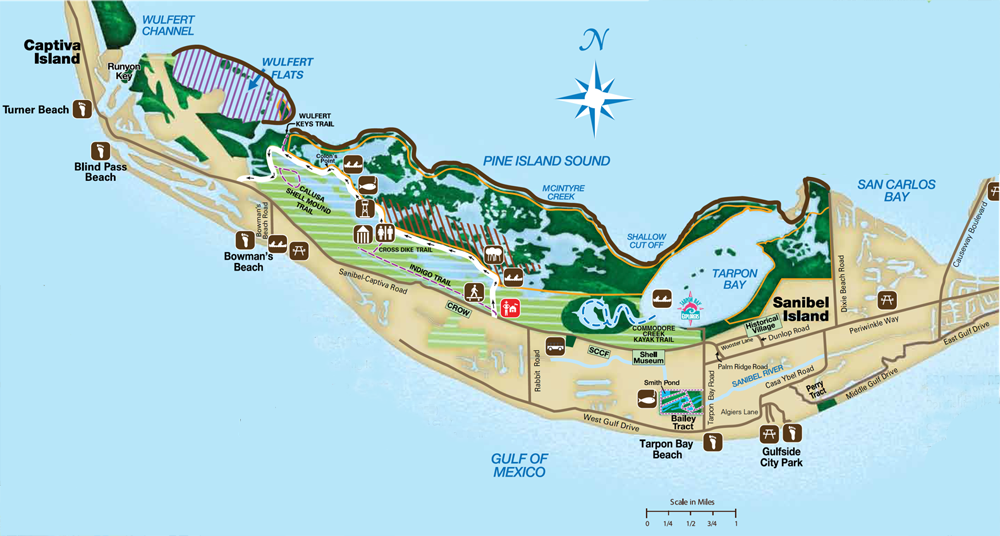
The subtropical barrier island of Sanibel came with 5-star recommendations. We'd allowed a whole day for lazing here, but the number of cars parked along the pencil-thin strip of scrub and sand lining Sanibel causeway, (and therefore only about 50 feet from the constant stream of cars) should have been a warning. It was literally impossible to find anywhere to park on the island itself. The road ran right down the center of the island so it was impossible to see the water, never mind walk along it. High hedgerows, walls, fences and trees prevented us from being able to see the properties that owned the coastline. We were in a vegetable tunnel. We drove the whole length of the island to Captiva, a pleasant enough cluster of clapboard houses, finally close enough to the road that we could enjoy them, but still from the car, due to lack of parking. There was even a brief stretch where the road ran behind the beach, but of course there was no way to park there either.
We were looking for The Mucky Duck, another multi-source recommendation. It was right at the very end of the road. The last 50 yards took 15 minutes to wait, shuffle, wait some more, and finally get the car turned around. Again, no chance of even getting out, never mind getting a space for the car, let alone a table for two. We found a spot outside "The Island Store" and took it as much out of principle as anything else. But it turned out to be a pretty cool general store, with anything and everything you could possibly need, much of it surprisingly upmarket. So we were able to buy a delicious picnic lunch, with gluten free this, and organic that. Several of the things we bought were home made. They even had good beer.
The J.N. "Ding" Darling National Wildlife Refuge is part of the largest undeveloped mangrove ecosystem in the United States. It is world famous for its spectacular migratory bird populations. We saw almost none of them. Mind you, it was noon-ish, hardly peak bird-watching time.
Jay Norwood Darling was instrumental in the effort to block the sale of a parcel of environmentally valuable land to developers on Sanibel Island. At Darling's urging, President Harry S. Truman signed an Executive Order creating the Sanibel National Wildlife Refuge in 1945. The refuge consists of over 6,400 acres of mangrove forest, submerged seagrass beds, cordgrass marshes, and West Indian hardwood hammocks. The refuge was created to safeguard and enhance the pristine wildlife habitat of Sanibel Island, to protect endangered and threatened species, and to provide feeding, nesting, and roosting areas for migratory birds. Today, the refuge provides important habitat to over 245 species of birds.

Having toured the visitor center, established that the next tour bus was already fully reserved, and that the next one was 90 minutes away, we decided to walk instead, and set off on the Indigo Trail. It was a delightful boardwalk and gravel path through a wooded area, which soon opened up into a much wider path through the marshland. The noonday sun was brutal and we quickly abandoned a plan to walk the full loop which at around 4 miles, would probably take us the best part of two hours. Besides, the wildlife also seemed to have done the sensible thing, and retreated to some shady and inaccessible spot. We did see a couple of wading birds strutting about on some mud flats, and a turtle basking on a log end just above the water, but that was about it. After less than half an hour we turned back, and were rewarded with an alligator sighting not far from the visitor center. Okay it was perhaps three feet long, probably closer to 30 inches than 36, but a sighting is a sighting. Well done to Claudia, I would have walked right by.
Back in the car and the AC, we trickled along the driving route through the refuge, and saw a much wider range of birds on the stretches of open water. We walked the short Wulfert Keys Trail out to the coast line, and watched dolphins cavorting about half a mile off shore in Pine Island Sound. At that point we were tipped back out onto the main drag, and made our way back into town. For completeness, we drove right to the lighthouse on the eastern tip of the island, and for consistency, we could not find anywhere to park so we could stroll around it. We gave up, reaffirmed that the causeway back to the mainland was the most picturesque, accessible, and parking friendly part of the whole island, and pushed on back towards Orlando. The beaches are still said to be stunning, and in another life if we were to get accommodation on the island it might be lovely. But for day visitors such as ourselves, it was something of a bust.
